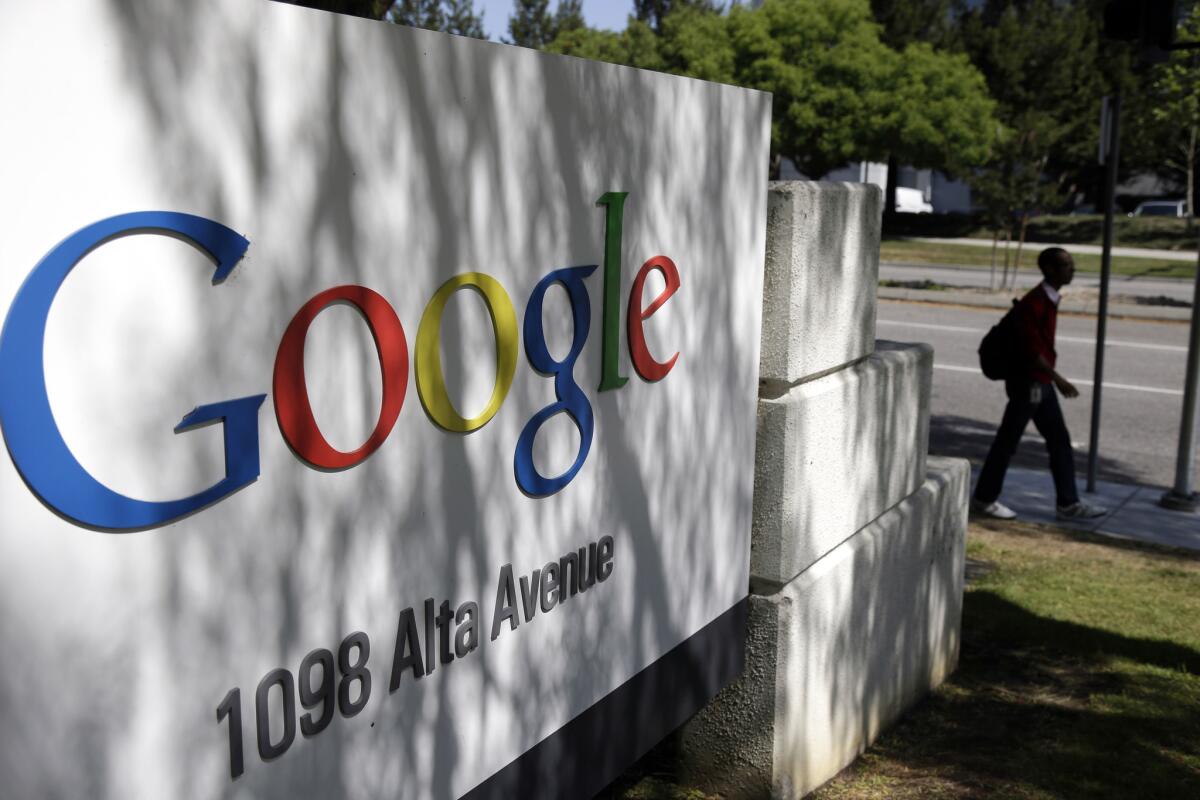Tech’s glass ceiling nearly four times harder for Asian Americans to crack

Google is among the companies with a large Asian American workforce, but few rise to the executive level, according to a recent report.
- Share via
Asian Americans are often considered the “successful minority” in tech. But that success has limits.
In an industry plagued by diversity issues, Asian Americans make up roughly a third of the workforce at Google, Yahoo and Facebook, according to the most recent Bureau of Labor Statistics figures. That far outpaces blacks and Latinos, who combined made up only single digits.
Although Asian Americans may be well represented in the workforce, they are severely underrepresented at the executive levels, according to a report released Wednesday by the Ascend Foundation, a nonprofit Pan-Asian membership organization for business professionals.
The report analyzed 2013 employment data filed with the U.S. Equal Employment Opportunity Commission by five major Silicon Valley tech companies: Google, Hewlett-Packard, Intel, LinkedIn and Yahoo.
The EEOC defines “Asian” as anyone with origins from the Far East, Southeast Asia or the Indian subcontinent. Using the data, the report’s coauthors developed the Executive Parity Index, a tool that measures whether the ratio of workers corresponds to the ratio of executive and managerial leaders at a company.
Race ended up being more significant than gender in accounting for differences in upward mobility in the workplace, said report coauthor Buck Gee, an executive advisor to Ascend and a former vice president and general manager of Cisco’s data center business unit.
“White men had a 42% advantage over white women [when it came to being promoted to the executive level], which was expected. But that paled in comparison to the 260% advantage they have to Asian women. So that was a big surprise,” Gee said.
The report, titled “Hidden in Plain Sight: Asian American Leaders in Silicon Valley,” also found that white men had a 150% advantage over Asian men, and white women have a 150% advantage over Asian American women.
From the sample of 139,000 employees across the five companies, white men and women were at parity when their numbers were measured against the Executive Parity Index, which is to say if women made up 15% of a company’s workforce, then they generally made up 15% of its managerial workforce, too.
When it came to minority men and women, however, all racial groups were well below parity. Gee noted that when the coauthors looked at black and Latino employees, the numbers were so low they could not even use the Executive Parity Index to accurately measure the ratio.
“It gives us an idea of what the dynamics of the pipeline are like,” Gee said.
The coauthors attributed the glass ceiling to “gaps in expectations,” and implicit biases.
“I consider myself third-generation Chinese American, and I grew up with my parents and grandparents, and their culture was what I grew up with,” said Janet Wong, one of the report’s coauthors and a retired partner at KPMG who spent 20 years working in Silicon Valley.
“They told me all I needed to do was stay in school, make good grades, and that was all I needed to be successful. They never taught me the soft skills or leadership skills. So when I started my career, I thought all I had to do was keep my head down, do good work, and I’d be acknowledged and have a successful career.”
Wong said it took several years in the workforce for her to understand that more was required of her in order to achieve a leadership position. She believes many Asian Americans working in tech could rise up the ranks if their companies provided adequate support and training.
When reached for comment about how they planned to address diversity within their organizations, Google pointed to its recently launched $150-million diversity initiative, which includes funding leadership programs and unconscious bias training.
LinkedIn, meanwhile, said it has invested in programs that have resulted in an increase in Asians in leadership positions, and Intel said it has created a $300-million diversity in technology fund. Yahoo directed The Times to a blog post containing its 2014 diversity numbers. Hewlett-Packard did not respond.
The report did not measure how much of the glass ceiling was due to the lack of soft skills -- such as being risk-averse, lacking vision or having poor relationship building skills -- and how much was a result of unconscious biases. The coauthors said the latter is an important factor that companies have to address.
Gee pointed to implicit biases such as the belief that Asians might be good engineers but poor leaders. But it goes further than that.
In a separate study published last year by UC Hastings College of the Law titled “Double Jeopardy,” the authors examined gender bias against women of color in science. They found that on top of the biases women already face in STEM fields, Asian women experience the double whammy of being negatively stereotyped and facing workplace pressures to fulfill traditionally feminine roles.
“All women walk this tightrope,” said Joan C. Williams, a professor at UC Hastings. “Asian women experience sharply higher levels of pressure to behave in feminine ways, and they experience higher levels of pushback if they don’t.”
Twitter: @traceylien
ALSO:
Opinion: Asian Americans would lose out under affirmative action
For Asian Americans, a changing landscape on college admissions
Pinterest, dominated by white and Asian workers, looks to diversify







